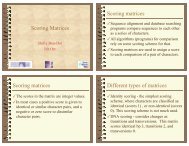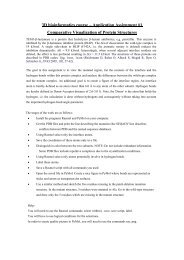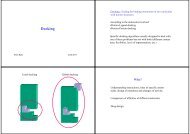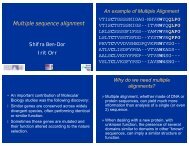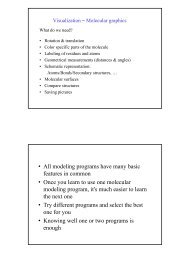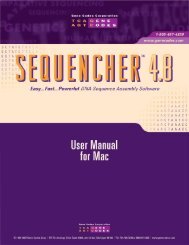Introduction to Phylogenetic Analysis
Introduction to Phylogenetic Analysis
Introduction to Phylogenetic Analysis
You also want an ePaper? Increase the reach of your titles
YUMPU automatically turns print PDFs into web optimized ePapers that Google loves.
Taken from Dr. Itai Yanai<br />
Estimating Confidence from the Resamplings<br />
1. Of the 100 trees:<br />
41/100 28/100 31/100<br />
Chimpanzee Human<br />
Gorilla Human Chimpanzee Human<br />
Gorilla<br />
Gibbon<br />
Orang-utan<br />
Chimpanzee<br />
In 41 of the 100 trees,<br />
chimp and gorilla are<br />
41<br />
split from the rest.<br />
Gorilla<br />
100<br />
Gibbon<br />
Gibbon<br />
Chimpanzee<br />
Gorilla<br />
Orang-utan Orang-utan<br />
2. Upon the original tree we superimpose bootstrap values:<br />
Human<br />
Gibbon<br />
Orang-utan<br />
Character Based Methods<br />
In 100 of the 100 trees,<br />
gibbon and orang-utan<br />
are split from the rest.<br />
All Character Based Methods assume that<br />
each character substitution is independent<br />
of its neighbors.<br />
Maximum Parsimony (minimum evolution)<br />
- in this method one tree will be given<br />
(built) with the fewest changes required <strong>to</strong><br />
explain (tree) the differences observed in<br />
the data.<br />
Statistical Methods<br />
Bootstrap values between 90-100 are<br />
considered statistically significant<br />
Character Based Methods<br />
Q: How do you find the minimum # of changes<br />
needed <strong>to</strong> explain the data in a given tree?<br />
A: The answer will be <strong>to</strong> construct a set of possible<br />
ways <strong>to</strong> get from one set <strong>to</strong> the other, and choose<br />
the "best". (for example: Maximum Parsimony)<br />
CCGCCACGA<br />
P P R<br />
CGGCCACGA<br />
R P R



